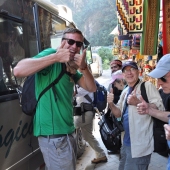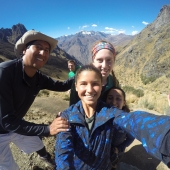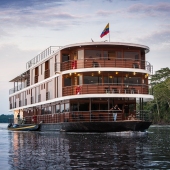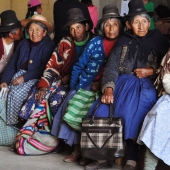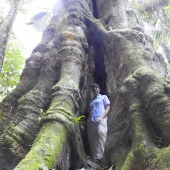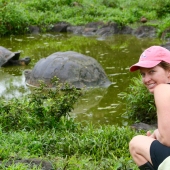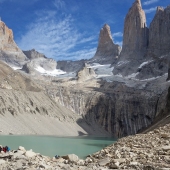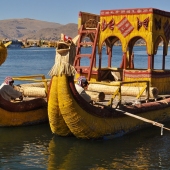
Machu Picchu: guide to Mosquitoes and Biting Insects
What should travelers going to Machu Picchu know about biting insects? Although Machu Picchu (8000 ft) is well above the 6500 foot altitude threshold for exposure to mosquitoes, it's still possible for a few of the little buggers to pop up and annoy you. But possibly more bothersome are tiny "midges" that can't be seen until it's too late. I have seen people in shorts with their legs covered in tiny bumps from these invisible, undetectable devils. Although they are not poisonous or vectors of disease, you don't want the most noteworthy memory of your amazing trip to be the itchy bumps on your legs. Welts can take several days and even weeks to disappear. You could still be scratching while planning your next adventure!
During the day at Machu Picchu, the temperature can spike up to the high 70s F for short periods of time. It's tempting to strip down to shorts and sandals. This is a huge mistake. With many choices of modern fabrics, wearing long pants in this semi tropical climate should not have a huge impact on your comfort. It's not an extremely warm climate. The nights are cool year round and the average daytime highs barely get into the 70s F. Using insect repellent is advisable as needed.
How to choose the best insect repellent
There are now many options for repellents including pump sprays, creams, lotions, bands and patches. There are formulas that contain Deet and those without. But what should you choose? Here is link to a resource that has researched and reviewed the best repellent. THE BEST MOSQUITO REPELLENT. I recommend going for the non-aerosol options to be the most eco-friendly. Using the bands, patches and lotions are less likely to have an impact on other people around you, not to mention the ruins themselves. What do I use? I am a magnet for mosquitos. I've tried everything without much success, including deet! So what do I use? I actually take a spoonful of nutritional yeast every day. Honestly, this works the best for me.
Most travlers want to minimize the load they carry around the ruins. For a 2-4 hour visit you still need basics like drinking water, sunscreen, hats and rain gear.
What to wear to minimize your need for insect repellents at Machu Picchu.
- Mosquitoes are more attracted to dark colors than light.
- Wear long pants. Light weight fabrics are suggested. Cinch the hem of the pant leg to prevent insects going up your pant leg.
- Keep your feet and ankles covered. Wear flat-soled sturdy shoes that cover your feet.
- Wear light colored socks (so you can see if insects are on you) that are long enough to cover your ankles and lower leg and tuck your pant leg in if necessary.
Machu Picchu Climate
There are two seasons in the Peruvian Andes Mountains. Wet and dry. The wet season usually begins in late December (ish) and continues through early April. Rainy season does not mean monsoon rains. For more details about weather rainfall and temperature charts, go to MACHU PICCHU & GALAPAGOS COMPREHENSIVE PACKING GUIDE. The average daily temperature does not fluctuate much during the year, so temperatures remain fairly constant year round. Cusco is cooler than the Sacred Valley and Machu Picchu.
Recommendations for Inca Trail Hikers:
We recommend that hikers use the same precautions as other visitors to Machu Picchu. The majority of most multi-day hikes including the Inca Trail, are at altitudes above 8000 feet and exposure to mosquitoes is low and even non-existent. But midges may pop up when you hike through lower elevations with temperature spikes during the day. These are perhaps more annoying than mosquitoes.
Amazon Jungle Recommendations:
The same rules apply to visitors to the jungle, with the additional recommendation to wear long sleeves. Although the lodges are elevated well above the floor of the jungle, we recommend that visitors keep their feet covered because of the unseen midges and sand flies. During the dry season (May-October) the mosquito population can be less than in wet season. But this also depends on the amount of rainfall. Sandflies are abundant during the dry season.
Galapagos Islands Recommendations:
There are very few insects in the islands, due to the isolated location and the distance from the mainland. Although the Islands are located on the equator in the tropics, the arid climate is not conducive for breeding mosquitoes. Visitors are rarely bothered by insects. However I do remember biting flies landing on my head while snorkeling near rocks with sunbathing sea lions. This was a rare distraction from the mostly insect-free paradise.
List of popular destinations in South America and their altitudes:
Peru:
Lima - coastal sea level
Cusco - 11,000 ft / 3350 m
Machu Picchu - 8000 ft / 2440 m
Arequipa - 7660 ft / 2335 m
Puno/Lake Titicaca - 12,500 ft /3800 m
Puerto Maldonado / Amazon Rain Forest - 600 ft / 183 m
Bolivia:
La Paz - 11,950 ft / 3640 m
Uyuni / Salt Flats - 12,000 ft / 3660 m
Santa Cruz - 1370 ft / 418 m
Rurrenabaque / Rain Forest - 675 ft / 206 m
Ecuador:
Quito - 9350 ft / 2850 m
Guayaquil - coastal sea level
Cuenca - 8400 ft / 2560 m
Mindo - 4265 ft / 1300 m
Banos - 5970 ft / 1820 m
Galapagos Islands - coastal sea level
Chile:
Santiago - 1706 ft / 520 m
Valparaiso - 33 ft / 10 m
San Pedro - 7900 ft / 2408 m
Punta Arenas - 112 ft / 34 m
Puerto Natales - 68 ft / 21 m
Here's a link to Adios Adventure Travel Peru Pre-Departure Info.


